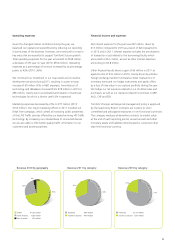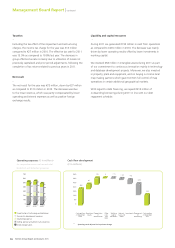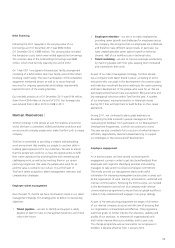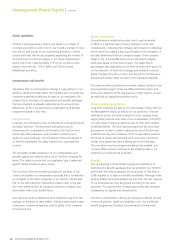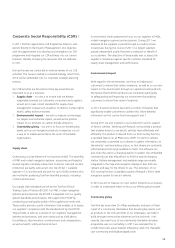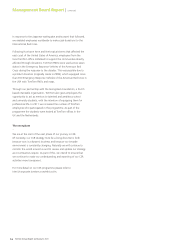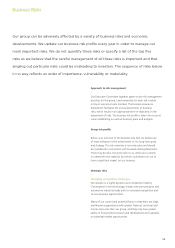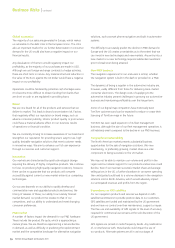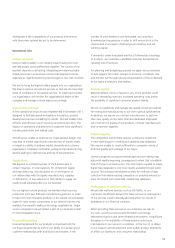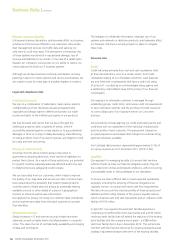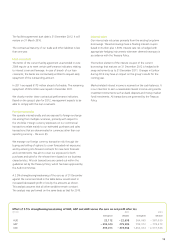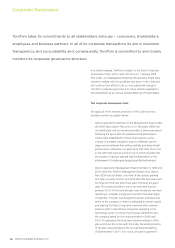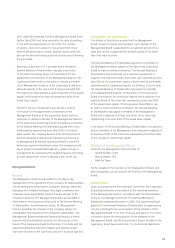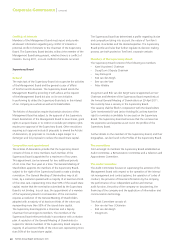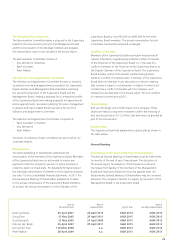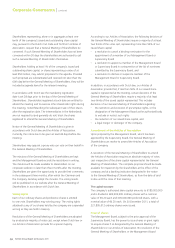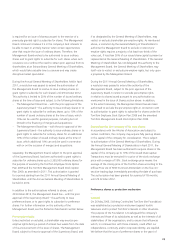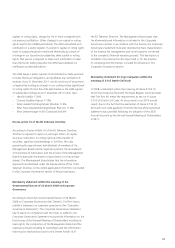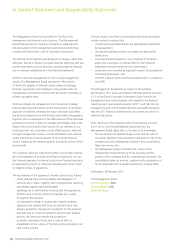TomTom 2011 Annual Report Download - page 20
Download and view the complete annual report
Please find page 20 of the 2011 TomTom annual report below. You can navigate through the pages in the report by either clicking on the pages listed below, or by using the keyword search tool below to find specific information within the annual report.TomTom Annual Report and Accounts 2011
18
Business Risks | continued
The leakage of confi dential information, improper use of our
systems and networks or defective products could adversely affect
our business. We have a security program in place to mitigate
these risks.
Financial risks
—
Credit
Credit risk arises primarily from cash and cash equivalents held
at fi nancial institutions, and, to a certain extent, from trade
receivables relating to our wholesale customers. Cash balances
are only held with counterparties that have a credit risk rating
of at least A – as rated by an acknowledged rating agency and
a satisfactory credit default swap (CDS) pricing of our fi nancial
counterparts.
Our exposure to wholesale customers is managed through
establishing proper credit limits, continuous credit risk assessments
of each individual customer and the purchase of credit insurance
to cover a large part of our exposure within our Consumer
business.
Our procedures include aligning our credit and trading terms and
conditions with our assessment of the individual characteristics
and risk profi le of each customer. This assessment is based on
our past experience and independent ratings from external rating
agencies whenever available.
Our total bad debt provision represented approximately 0.1% of
our group revenue as of 31 December 2011 (2010: 0.2%).
Liquidity
Our approach to managing liquidity is to ensure that we have
suffi cient funds to meet our fi nancial obligations when they fall
due under both normal and stressed conditions, without incurring
unacceptable losses or risking damage to our reputation.
To ensure we have suffi cient cash to meet expected operational
expenses, including the servicing of fi nancial obligations we
regularly monitor our actual and future cash fl ow requirements.
We take into account the maturity profi les of fi nancial assets and
liabilities and the rolling forecast of the group’s liquidity reserve,
which comprises cash and cash equivalents and an undrawn credit
facility of €174 million.
In April 2011 we signed a forward-start facilities agreement
comprising of a €250 million term loan facility and a €150 million
revolving credit facility that will extend the maturity of the existing
bank facilities that the company has in place – a €388 million
term loan facility that is due in December 2012. This will provide
TomTom with the fi nancial resources for ongoing operational and
strategic requirements beyond the term of the existing facilities.
Disaster recovery planning
Unforeseen business disruptions could severely affect our business
activities and the services offered to our customers. We provide
fl eet management services, live traffi c data and sales via our
web store on a 24-hour basis. The permanent or temporary loss
of these systems would result in reputational damage, loss of
revenue and liabilities to our clients. In the case of a catastrophic
disaster our company’s success rests on our ability to restore our
critical data and re-build our IT business systems.
Although we do have business continuity and disaster recovery
planning in place for certain systems and various eventualities, we
are unable to plan for every type of possible disaster or incident.
Legal and compliance risks
—
Intellectual property
We rely on a combination of trademarks, trade names, patents,
confi dentiality and non-disclosure clauses and agreements,
copyrights and design rights to defend and protect our trade
secrets and rights to the intellectual property in our products.
We may be faced with claims that we have infringed the
intellectual property rights or patents of others, which if
successfully asserted against us may require us to pay substantial
damages or force us to stop or delay developing, manufacturing
or selling products. Even if we were to prevail, any litigation could
be costly and time-consuming.
Privacy of customer data
Growing concerns about location privacy may result in
governments adopting additional, more restrictive legislation to
protect their citizens. As a result of these restrictions, our potential
for growth could be materially adversely affected and/or the cost
to implement privacy safeguards could increase.
We use trace data from our customers, which helps to improve
the quality of our map data and services we offer. Concerns have
been raised about the possibility that location-based products
could be used to violate personal privacy by potentially making
available a record or other details of a person’s geographical
location to others as well as law enforcement.
Our approach to privacy is to keep our customer data confi dential
and anonymise trace data from individual customers to protect
their identities.
Information security
Global increases in IT and Internet security threats have been
observed, as well as higher levels of professionalism in computer
crime. This raises the risk of confi dentiality, availability and integrity
of data and information.



